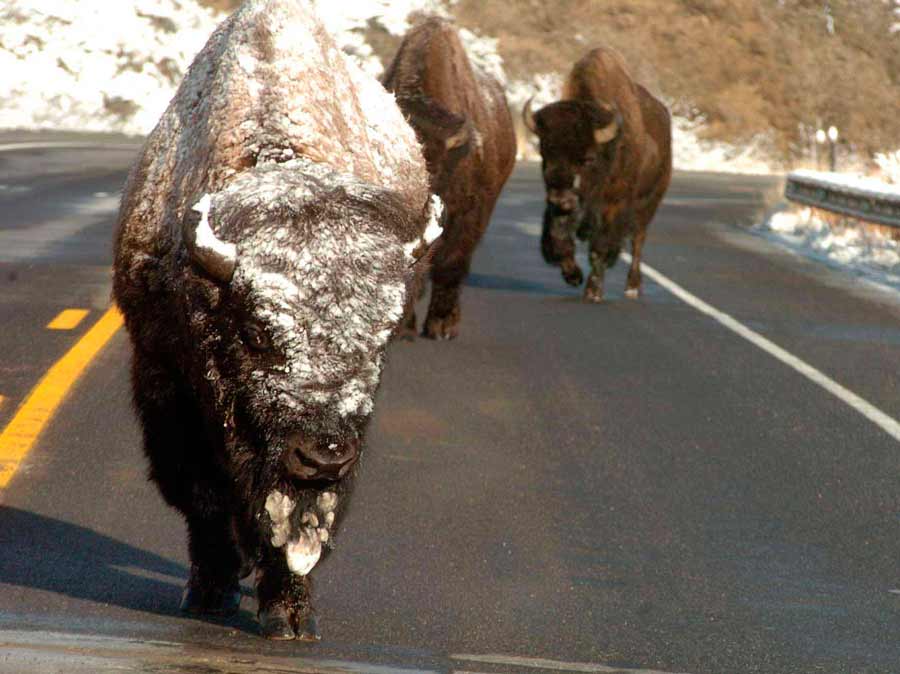
A trio of bison make their way along a highway near Yellowstone National Park. (Ruffin Prevost/Yellowstone Gate – click to enlarge)
Yellowstone Gate publishes occasional guest commentaries on topics of interest to our readers. The views and opinions expressed are not necessarily those of this publication.
By Stephany Seay
Traveling to the West Yellowstone, Mont. area? Be advised: the wild bison migration is underway, and bison are currently on or near the highways, day and night.
Moving toward their calving grounds, members from the central herds of Yellowstone National Park roam out of the park’s high-elevation, snow-covered lands into the exposed, south-facing slopes of Horse Butte and surrounding lands in the Madison River corridor. Enjoy the experience of this awesome annual event.
People traveling on Highway 191 from Fir Ridge south to West Yellowstone should be prepared to take a few extra minutes. Bison also travel along Highway 287 from the 191 Junction to Kirkwood, and Highway 20 from West Yellowstone to Targhee Pass.
As the continent’s ancient buffalo traces have become many of our major and minor highways, this unfortunately means that some bison never make it to their natal lands, but instead end up at the dump after being killed by speeding motorists. Six bison have already been struck and killed by motorists this season, five of these within 72 hours, and all at night.
Because of their dark color and eye placement, bison are extremely hard to see at night, often not until it is too late.
Warnings and lower speed limits are in place in many locations, and wisdom will encourage you to heed these. The Montana Department of Transportation gives general warnings with “Caution: Animals on Road” marquees in significant locations, as well as “Bison on Road: 55mph” warning signs. Signs are generally up from winter through spring.
Buffalo Field Campaign takes things even further, becoming bison crossing guards. We rove the highways in bison migration corridors and set up our highly visible hot pink signs warning “Buffalo Ahead,” “Buffalo on Road” or “Buffalo X-ing” when bison are on or next to the road. If you see these hot pink signs, there are bison ahead!
Some helpful hints:
- From March through June, expect that bison will be on the road, any time of day or night.
- Heed the warning signs. If you see hot pink signs, slow down.
- A little patience goes a long way. An extra 5 minutes of your time could be the difference between your safe arrival or a totaled car, injuries or worse, including a dead bison.
- Slow down, turn on your hazards, and let the bison move in the direction they are headed. Speeding through them or causing them to scatter is not only rude but dangerous.
- Don’t honk. It doesn’t keep bison from crossing but can cause moments of chaos that delays the success of their crossing.
- Don’t pull over in their path or pull right up alongside of them. Blocking the direction of the animals’ path only keeps them on the road longer. Be mindful, especially when there is snow on the ground, that bison need to have a clear exit to get off the road.
Buffalo Field Campaign has contacted Montana’s congressional delegation and Gov. Steve Bullock asking that they secure the necessary funding to make highways safer for wildlife and people with safe-passage infrastructure. Until then, heed the warnings and slow down for wild bison. The life you save may be your own.
This is as much about human safety as it is to safeguard America’s last wild bison. Buffalo Field Campaign is doing everything we can with the resources we have, but we cannot always be out there.
Stephany Seay is the media coordinator for Buffalo Field Campaign, a nonprofit group based in West Yellowstone, Mont. advocating for free-roaming wild bison in the greater Yellowstone area.

Dear Stephany,
It might behoove you and your organization, Buffalo Field Campaign, to contact the chief ranger in Yellowstone and advise him/her of the unsafe practices and, frankly, wreckless driving, of the Ride and Share bus transporting park employees from Livingston, Mont. to Yellowstone Monday thru Thursday.
A section of US Highway 89 with a cattle guard specifically designed to stop Yellowstone buffalo from migrating further into Montana on the upper end of Yankee Jim Canyon has a posted speed limit of 35mph. This NPS commuter bus does not slow down to 35mph from its average speed of over 60 mph through wildlife-laden Paradise Valley and the outskirts of Gardiner, Mont. In fact, it does not even apply brakes to slow even slightly, as evidenced by the lack of brake lights. Any licensed experienced driver can stand along side a given roadway and correctly distinguish a 30 mph difference- i.e.,65 mph to 35 mph, or, for that matter 45 mph to 15 mph – of a moving vehicle.
I have contacted Superintendent Dan Wenk on this matter, yet he advises the bus is operated safely. It is not as there are occasionally buffalo present in the valley.
Perhaps Montana Highway Patrol needs to be contacted as well, as does a federal agency overseeing the safe operation of motor carriers.
Thank You,
Steve Torrey
Cody, Wyoming